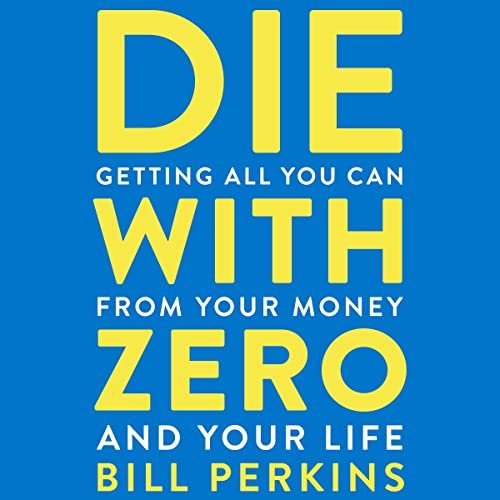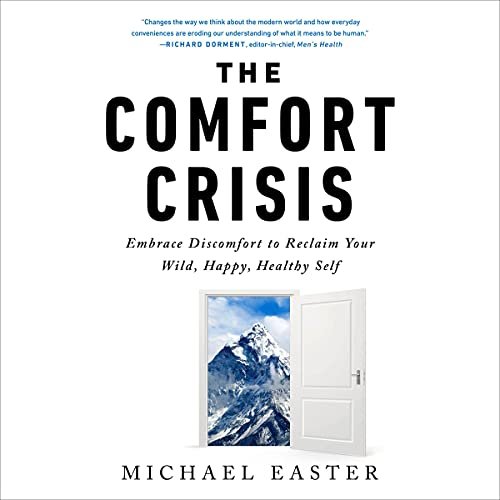I love books that keep me from sliding into autopilot mode in life. These two books behind my winter in Alaska inspiration are the spark that lit a fire under my butt. Read them, and you never know what kind of crazy life changes you might concoct too.

Die with Zero: Getting All You Can from Your Money and Your Life
From Amazon: A common-sense guide to living rich—instead of dying rich
Imagine if by the time you died, you did everything you were told to. You worked hard, saved your money, and looked forward to financial freedom when you retired.
The only thing you wasted along the way was—your life.
Die with Zero presents a startling new and provocative philosophy as well as practical guide on how to get the most out of your money—and out of your life. It’s intended for those who place lifelong memorable experiences far ahead of simply making and accumulating money for one’s so-called Golden Years.
In short, Bill Perkins wants to rescue you from over-saving and under-living. Regardless of your age, Die with Zero will teach you Perkins’ plan for optimizing your life, stage by stage, so you’re fully engaged and enjoying what you’ve worked and saved for.
You’ll discover how to maximize your lifetime memorable moments with experience bucketing, how to convert your earnings into priceless memories by following your net worth curve, and find out how to navigate whether to invest in, or delay, a meaningful adventure based on your spend curve and personal interest rate.
I didn’t know about the Die With Zero book until I listened to Bill Perkins on The Peter Attia Drive podcast. While running along the Coachella canal one morning, I assumed the guy was there to talk about self-help concepts that I’ve already put into practice, like finding purpose, being true to yourself, etc. But it was his ideas about over-saving and under-living that grabbed me.
As self-employed, childfree people, Jim and I have always been diligent retirement savers. There won’t be any kids to watch out for us when the wheels start falling off someday, so we need enough money to pay for care. We want that money to fund some excellent adventures, too. And we sacrifice a lot for the peace of mind knowing that we might actually achieve this, with the comparatively little bit of cash we are able to stash away.
But then Bill’s book got me thinking: are we sacrificing too much? Where do we draw the line between respectable saving for the future, versus enjoying what that cash can do today?
And what if we drop dead before we can have fun with our retirement funds? What if all the sacrifices were for nothing?
The Die with Zero concept set me straight. It argues that most people who are good savers, are stashing too much money away for their later years. Most savers die without actually getting to enjoy the fruits of their labors.
Conventional financial wisdom has conditioned us to fear having too little as we age; actual data shows the opposite.
Die with Zero
For heads of household between the ages of 70 and 74, the median net worth is $225,390. Too late to enjoy many of life’s most fulfilling experiences.
I bought the book and devoured it. Die with Zero turned my concepts about saving for the future upside down. No, I’m not going to go on a mad spending spree. I won’t burn through our retirement funds either. But what I am going to do is put my fear of going broke aside. I’m going to be OK with paying the price for a once-in-a-lifetime winter in Alaska. We are doing this, before we are too old to give it a whirl.
Watch Bill explain Die with Zero and you’ll be convinced why it’s important to experience more of life, today.
Book #2 as a Source of Winter in Alaska Inspiration: The Comfort Crisis
This book instantly caught my attention when it was mentioned on a podcast with Akshay Nanavati, author of Fearvana. That’s another life-changing book I love.
The Comfort Crisis: Embrace Discomfort to Reclaim Your Wild, Happy, Healthy Self
From Amazon: Discover the evolutionary mind and body benefits of living at the edges of your comfort zone and reconnecting with the wild.
In many ways, we’re more comfortable than ever before. But could our sheltered, temperature-controlled, overfed, underchallenged lives actually be the leading cause of many our most urgent physical and mental health issues? In this gripping investigation, award-winning journalist Michael Easter seeks out off-the-grid visionaries, disruptive genius researchers, and mind-body conditioning trailblazers who are unlocking the life-enhancing secrets of a counterintuitive solution: discomfort. . .
Along the way, Easter uncovers a blueprint for leveraging the power of discomfort that will dramatically improve our health and happiness, and perhaps even help us understand what it means to be human. The Comfort Crisis is a bold call to break out of your comfort zone and explore the wild within yourself.
I didn’t even know what this book was about. But I knew that if Akshay raved about it, I should check it out. I’m glad I did. Together with Die with Zero, it dovetailed perfectly into the great winter in Alaska plan that I hatched.
Being uncomfortable is nothing new to me, or to Jim. After all, I choose to run marathons. I don’t mind getting my hands dirty. And I’ve lived in a tiny box with my husband for the last 15 years. We’ve also in business together for over 20. WE know about being uncomfortable!
But choosing to be part of some uncomfortable full-time RVing situations, like winter boondocking, is no longer routine. We’ve been avoiding them more and more.
I never thought that my reluctance fear of being uncomfortable was harming my quality of life. Then I read The Comfort Crisis.
Most people today rarely step outside their comfort zones. We are living progressively sheltered, sterile, temperature-controlled, overfed, underchallenged, safety-netted lives. And it’s limiting the degree to which we experience our “one wild and precious life,†as poet Mary Oliver put it.
But a radical new body of evidence shows that people are at their best—physically harder, mentally tougher, and spiritually sounder—after experiencing the same discomforts our early ancestors were exposed to every day. Scientists are finding that certain discomforts protect us from physical and psychological problems like obesity, heart disease, cancers, diabetes, depression, and anxiety, and even more fundamental issues like feeling a lack of meaning and purpose.
Michael Easter, The Comfort Crisis
For many people, full-time RVing for 15 years is not a comfortable existence. But I don’t mind it at all. I really love it. But there was a day when I felt invigorated by raw, upfront encounters with nature. Sleeping in a tent. Rising with the sun. Living without electricity. These harsh realities once made me feel more alive than I do when I’m living on AC power.
Don’t get me wrong, I love RV living. I don’t want to live a permanent hobbit existence. But I know there’s more of this world to experience. And it lays way beyond the comfort of our four-season fifth wheel.
I’m more driven than ever to go explore my limits of discomfort. How? By experiencing one of the harshest winters on the North American continent.
Here’s Michael explaining why we all need to get more comfortable with being uncomfortable on The Peter Attia Drive podcast:
There Will Be More Winter in Alaska Inspiration to Come
It’s a chilly 50-something degrees here tonight in the desert. Yeah, that’s nothing, I know. So as I read blogs with titles like Things I had to learn the hard way during my first winter in Alaska. I’m more inspired than ever to put my fears aside. This crazy plan is a GO! Join me and Jim from for the ride. It won’t always be comfortable. But it sure beats not knowing what conditions we are really capable of handling in this wild world of ours. You might want to do it someday, too.


I look forward to hearing all about Alaska in Winter. I am sure it will be incredible
We are going again next year…summer for us.😁